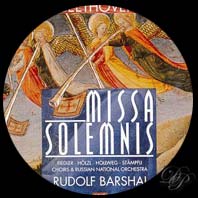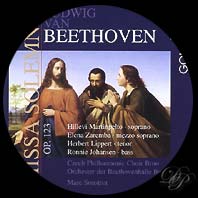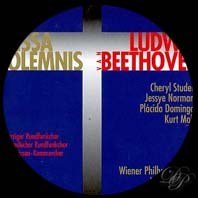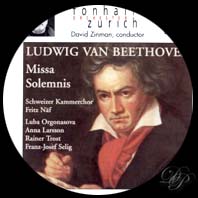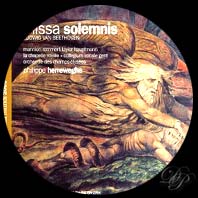| |
|
 |
Présentation réalisée par Daniel Achache |
| |
La Missa Solemnis de Beethoven, en ré majeur (sa messe n°2) est une œuvre monumentale, non seulement par sa durée, avoisinant 80 minutes, mais surtout par son contenu, absolument stupéfiant. Avec la Messe en Si Mineur de J. S. Bach, elle est l’un des deux sommets de toute la musique sacrée. Notons qu’à la différence de celle-ci, elle ne comporte aucun air pour solistes : c’est essentiellement une œuvre chorale, avec participation active des solistes. Cette œuvre complexe ne se livre pas aisément à l’auditeur, contrairement à d’autres œuvres de Beethoven tels que ses concertos ou ses symphonies. Son approche et sa compréhension nécessitent de nombreuses auditions. Heureusement, les auditeurs actuels ont le privilège de pouvoir écouter et réécouter les enregistrements réalisés par les plus grands chefs, avec des chanteurs prestigieux, des chœurs et des orchestres de haut niveau. Elle est peu jouée en concert, vu les moyens qu’elle nécessite. Quant à son exécution à l’église, en temps que messe, elle est assez rarissime. |
|
|
Beethoven consacra beaucoup de son temps et de son énergie à la composition de cette œuvre : il ne lui fallut pas moins de 4 ans pour arriver à son terme. Commencée en avril 1819, elle était, à l’origine, destinée à l’intronisation de l’archiduc Rodolph, comme archevêque d’Olmutz, prévue pour mars 1820. En fait l’œuvre ne fut achevée qu’en mars 1823. Ce long travail aboutit à une œuvre inouïe, remarquable sur le plan thématique, harmonique, rythmique, vocal et orchestral. La première audition partielle (Kyrie, Credo, Agnus Dei), n’eut lieu que lors du concert du 7 mai 1824. Ce concert comprenait également son opus 124, l’ouverture "la consécration de la maison" et l’opus 125, à savoir la 9 e symphonie. La première édition date de 1827. En tête du Kyrie, qui ouvre l’œuvre, Beethoven écrivit : "Vom Herzen,möge es wieder, zu Herzen gehen !" ce que l’on peut traduire par : "Venant du cœur, qu’elle puisse retourner au cœur !" ou bien : "Venue du cœur, qu’elle retourne au cœur !". |
L’exécution de cette œuvre nécessite : - 4 grands chanteurs : soprano, alto, ténor, basse ; - un grand chœur à 4 voix ; - un important orchestre constitué de :
|
Le présent chapitre ne constitue pas une analyse de l’œuvre, mais est simplement un guide permettant de faciliter l’écoute. La Missa Solemnis comporte les 5 parties classiques. I - KYRIE (durée : 9 à 11 minutes).1- Assai sostenuto, Mit Andacht (avec dévotion).
2- Andante assai ben marcato.
3- Tempo primo.
II - GLORIA (durée : 16 à 18 minutes).Ce morceau est, à lui seul, un chef-d’œuvre. On peut le diviser en 8 parties, toutes enchaînées. 1 – Allegro vivace "Gloria In Excelsis Deo ".
2 – Meno allegro "Gratias " .
3 – Allegro vivace "Domine Deus ".
4 – Larghetto "Qui Tollis ".
5 – Allegro maestoso "Quoniam".
6 – Allegro ma non troppo "In Gloria Dei Patris".
7 – Poco più allegro "Amen".
8 – Presto "Gloria In Excelcis Deo".
III - CREDO (durée 19 à 21 minutes).Ce morceau est un autre moment fort de la Missa Solemnis et aussi le plus long. Il comporte de nombreuses variations de tempo, de tonalité, de rythme, et aussi des changements de nuances, fréquents et brutaux (passage des pp aux ff et inversement). On peut distinguer 9 parties, toutes enchaînées : 1 – Allegro ma non troppo "Credo In Unum Deum" .
2 – Adagio "Et Incarnatus".
3 – Adagio espressivo – "Crucifixus".
4 – Allegro (très court) – "Et Resurrexit".
5 - Allegro molto – "Et Ascendit".
6 – Allegretto ma non troppo – "Credo In Spiritum" (chœur).
7 – Allegro ma non troppo – "Et Vitam Venturi".
8 – Allegro con moto.
9 – Grave – "Et Vitam Venturi".
IV – SANCTUS et BENEDICTUS (durée 15 à 17 minutes).Ces 2 parties sont reliées entre elles par le praeludium orchestral. LE SANCTUS. 1 – Adagio (Mit andacht).
2 – Allegro pesante.
3 – Presto.
4 – Sostenuto ma non troppo.
LE BENEDICTUS Il a la particularité d’être une sorte de mouvement lent de concerto de violon : en effet celui-ci joue, durant tout le Benedictus, une partie suraiguë très difficile. C’est un "andante molto cantabile e non troppo mosso". Il y a un long dialogue entre le chœur et les 4 solistes, jusqu’à la reprise, par le chœur, de l’Osanna fugué (doublé au début par les 3 trombones, avant la dernière entrée du violon). V – AGNUS DEI (durée : environ 15 minutes).Il comporte 4 parties: 1- Adagio "Agnus Dei".
2 – Allegretto vivace.
3 – Allegro assai.
4 – Presto.
|
Kyrie |
|
| Kyrie eleison! Christe eleison! |
Lord, have mercy upon us! Christ have mercy upon us! |
Gloria |
|
| Gloria in excelsis Deo, et in terra pax hominibus bonae voluntatis. | Glory be to God on high, and peace on earth to men of good will. |
| Laudamus te, benedicimus te, adoramus te, glorificamus te. | We praise Thee, we bless Thee, We adore Thee, we glorify Thee |
| Gratias agimus tibi propter magnam gloriam tuam. | We give Thee thanks for Thy great glory. |
| Domine Deus, Rex cælestis! Deus Pater omnipotens! domine, Fili unigenite, Jesu Christe! |
O Lord God! O heavenly King! O God, the Father Almighty! O Lord Jesus Christ, the only-begotton Son! |
| Domine Deus! Agnus Dei! Filius Patris! | O Lord God! Lamb of God! Son of the Father! |
| Qui tollis peccata mundi! miserere nobis; suscipe depracationem nostram. | O Thou, who takest away the sins of the world! have mercy upon us; receive our prayer. |
| Qui sedes ad dexteram Patris, miserere nobis. | O Thou, who sittest at the right hand of the Father! have mercy on us. |
| Quoniam tu solus sanctus, tu solus Dominus, tu solus altissimus, Jesu Christe! cum Sancto Spiritu in gloria Dei Patris, Amen. | For Thou alone art holy, Thou alone art Lord, Thous alone art most high, O jesus Christ! together with the Holy Ghost, in the glory of God the Father, Amen. |
Credo |
|
| Credo in unum Deum, patrem omnipotentem, factorem cæli et terræ visibilium omnium et invisibilium. | I believe in one God, the Father Almighty, maker of heaven and earth, of all things visible and invisible. |
| Credo in unum Dominum Jesum Christum, | I believe in one Lord Jesus Christ, |
| Filium Dei unigenitum; et ex Patre natum ante omnia sæcula. | the only-begotten Son of God; and born of the Father before all ages. |
| Deum de Deo, Lumen de Lumine: | God of Gods, Light of Light, |
| Deum verum de Deo vero; | true God of true God; |
| Genitum, non factum; consubstantialem Patri, per quem omnia facta sunt; | begotten, not made; consubstantial to the Father, by Whom all things were made; |
| Qui propter nos homines, et propter nostram salutem, descendit de cælis, | Who for us men and for our salvation, came down from heaven, |
| et incarnatus est de Spiritu Sancto ex maria Virgine, et homo factus est. | and became incarnate by the Holy Ghost of the Virgin Mary, and was made man. |
| Crucifixus etiam pro nobis; sub Pontio Pilato passus et sepultus est, | He was crucified also forus; suffered under Pontius Pilate and was buried, |
| Et resurrexit tertia die, secundum Scripturas. | And the third day He arose again according to the Scriptures. |
| Et ascendit in cælum, sedet ad dexteram Patris. | And ascended into heaven, and sitteth at the right hand of the Father. |
| Et iterum venturus est cum gloria judicare vivos et mortuos; cujus regni non erit finis. | And He is to come again, with glory, to judge both the living and the dead; of whose kingdom there shall be no end. |
| Credo in Spiritum Sanctum, Dominum et vivificantem, | I believe in the Holy Ghost, the Lord and Giver of life, |
| qui ex Patre Filioque procedit; qui cum Patre et Filio simul adoratur et conglorificatur; qui locutus est per prophetas. | Who proceedeth from the Father and the Son; Who, together with the Father and the Son, is adored and glorified; Who spoke by the prophets. |
| Credo in unam sanctam Catholicam et Apostolicam Ecclesiam. | I believe in one holy Catholic and Apostolic Church. |
| Confiteor unum Baptisma in remissionem peccatorum. | I confess one baptism for the remission of sins. |
| Et expecto resurrectionem mortuorum, et vitam venturi sæculi. Amen. | And I expect the resurrection of the dead, and the life of the world to come. Amen. |
Sanctus |
|
| Sanctus Dominus Deus Sabaoth. | Holy is the Lord God Sabaoth. |
| Pleni sunt cæli et terra gloria tua. | Heaven and earth are fully of Thy Glory. |
| Osanna in excelsis! | Hosanna in the highest! |
| Benedictus qui venit in nomine Domini! | Blessed is he who cometh in the name of the Lord! |
| Osanna in excelsis! | Hosanna in the highest! |
Agnus Dei |
|
| Agnus Dei, qui tollis peccata mundi, miserere nobis, dona nobis pacem. | O Lamb of God, that takest away the sins of the world, have mercy upon us, grant us peace. |
| En conclusion, citons le compositeur lui-même : "La plus grande œuvre que j'aie jamais composée". |
|
|
|
|
| Chef d'orchestre | Orchestre | Année | Label | Disponible | |
Rudolf BARSHAI |
Chors and Russian National Orchestra |
1994 |
Laserlight |
||
Leonard BERNSTEIN |
New York |
Sony Classical |
|||
Leonard BERNSTEIN |
Concertgebouw Orchestra Amsterdam |
En ublic |
Deutsche Grammophon |
||
Karl BOEHM |
Berliner Philharmoniker |
1955 |
Deutsche Grammophon |
||
Karl BOEHM |
Wiener Philharmoniker |
1975 |
Deutsche Grammophon |
||
Colin DAVIS |
London Symphony Orchestra |
1979 |
Philips |
||
Colin DAVIS |
Bavarian Radio Symphony Orchestra |
1992 |
RCA |
||
Antal DORATI |
European Symphony Orchestra |
1994 |
Bis |
||
Eliott GARDINER |
English Baroque Soloists |
1990 |
Deutsche Grammophon |
||
Carlo Maria GIULINI |
London Philharmonic Orchestra |
En public |
EMI |
||
Nikolaus HARNONCOURT |
Chamber Orchestra of Europe |
En public |
Teldec |
||
Philippe HERREWEGHE |
Orchestre des Champs-Elysées |
En public |
Harmonia Mundi |
||
Eugen JOCHUM |
Orchestre du Royal Concertgebouw |
1971 |
Philips | - |
|
Hebert van KARAJAN |
Philharmonia Orchestra of London |
1958 |
Testament |
||
Hebert van KARAJAN |
Wiener Philharmoniker |
1959 |
EMI |
||
Hebert van KARAJAN |
Berliner Philharmoniker |
1966 |
Deutsche Grammophon | ||
Hebert van KARAJAN |
Berliner Philharmoniker |
1975 |
Deutsche Grammophon | - | |
Hebert van KARAJAN |
Berliner Philharmoniker |
1985 |
Deutsche Grammophon | ||
Otto KLEMPERER |
Wiener Symphoniker |
? |
Vox |
||
Otto KLEMPERER |
Kölner Rundfunk-Sinfonie-Orchester |
1955 |
Medici Masters |
||
Otto KLEMPERER |
Phiharmonia Orchestra |
1963 |
BBC - Testament |
||
Otto KLEMPERER |
New Phiharmonia Orchestra |
1965 |
Emi |
||
| Terje KVAM | The Hanover Band Oslo Cathedral Choir |
1987 | Nimbus Records | ||
James LEVINE |
Wiener Philharmoniker |
En public |
Deutsche Grammophon |
||
Kurt MASUR |
Gewandhausorchester Leipzig |
1972 |
Berlin Classics |
||
| Helmuth RILLING | Bach Collegium Stuttgart Gächinger Kantorei Stuttgart |
1988 | Hänssler | ||
| Kenneth SCHERMERHORN | Nashville Symphony Orchestra and Chorus |
2003 | Naxos | ||
Georg SOLTI |
Chicago Symphony Orchestra |
1978 |
London |
||
Marc SOUSTROT |
Beethovenorchester Bonn |
2002 |
MDG |
||
Arturo TOSCANINI |
NBC Symphony Orchestra |
1953 |
Music & Arts |
||
| Heinz WALLBERG | Wiener Philharmoniker |
1965 | Atlas | - | |
Günter WAND |
Orchestra of the Gürzenich of Cologne |
Testament |
|||
David ZINMAN |
Tonhalle-Orchestre Zurich |
2001 |
Arte Nova |
|
|
|
|
|
|||||||||||||||||

